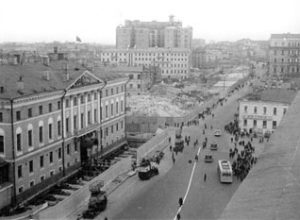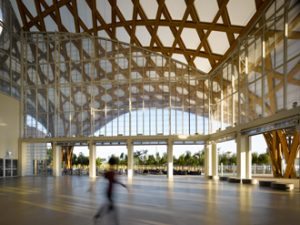
Laurent Le Bon, the new Director of the Pompidou Center-Metz (which was inaugurated in May 2010), responds to Callu on the level of achieved results. Le Bon has headed up an unprecedented experiment–one Picon would perhaps have approved of–that follows in the wake of what French President Georges Pompidou attempted and succeeded in imposing for Paris in 1977. The new Metz Museum is said to be the inspired sequel to the interdisciplinary Center that arose on the Beaubourg plain in Paris, and not a mere duplicate thereof, founded elsewhere. For, the atmosphere of the two projects is not the same, and history required that it be begun anew, in partnership with various local and regional authorities. The Metz version is also served by an architectural design that is transparent and user-friendly; inside and outside are brought into relation with each other. The outside, moreover, is necessarily altered by this architectural presence, which is open to a visiting public that is itself in the process of construction and that, as one already knows, goes far beyond the limit of regular visitors to cultural institutions.
Laurence Bertrand Dorléac
The Pompidou Center-Metz:
A New European Cultural Institution
Laurent Le Bon
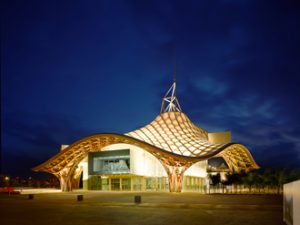
1. Overall view of the Pompidou Center-Metz at night. © Centre Pompidou-Metz; Shigeru Ban Architects Europe and Jean de Gastines Architectes, with Philip Gumuchdjian for the competition-winning project design/Metz Métropole/Pompidou Center-Metz/Photo: Roland Halbe.
The first attempt to decentralize a public cultural establishment in France in partnership with local and regional authorities, the Pompidou Center-Metz [ref]The main contractor for the Pompidou Center-Metz was Metz Métropole, the main financial backer for the facility, in partnership with the City of Metz (official agent) and the Pompidou Center. Construction of the Pompidou Center-Metz has also received financial support from the Departmental Council of Moselle, the Regional Council of Lorraine, the French State, and the European Union (European Development Fund). The total cost for the project came to 72 million euros, before taxes. In late 2008, the Pompidou Center-Metz became a government-owned cultural-cooperation corporation whose founding members are the French State, the Pompidou Center, the Region of Lorraine, the Metz Metropolitan Community, and the City of Metz.
Main Participants :
Contractor: Metz Metropolitan Community
Official Agent: City of Metz
Partner of the Contractor: Pompidou Center, Paris
Architects: Shigeru Ban Architects Europe et Jean de Gastines Architectes, Paris
Associate Architect for the Competition Phase: Philip Gumuchdjian Architect, London.
Bureaux d’études techniques : Arup, Londres, et Terrell, Boulogne-Billancourt.
Entreprise générale : Demathieu & Bard, Montigny-lès-Metz.
Entreprise de charpente métallique : Viry, Eloyes.
Entreprise de charpente bois : Holzbau Amann, Weilheim-Bannholz, Allemagne.
Entreprise pour la membrane : Taiyo Europe, Munich, Allemagne
[/ref] has set as its mission to exhibit all forms of creative artistry since 1905. Neither a museum nor a miniature version of the Pompidou Center in Paris, the Pompidou Center-Metz (see Fig. 1) is responsible for extending the spirit and adventure of the original, of which it is the sister institution. It determines its own programming autonomously while taking its inspiration from the founding principles of the Pompidou Center, which include: innovation, generosity, cultural democratization, and multidisciplinarity. Furthermore, it relies on the Pompidou Center’s existing expertise, networks, and fame. In carrying forth those values, the Pompidou Center-Metz benefits from a unique advantage: the ability to obtain loans from the French National Museum of Modern Art, which, with more than sixty-thousand works, possesses the largest collection of modern art in Europe.
A Unique Architecture

2. View of the Forum and the roofing structure with its transparent membrane, Pompidou Center-Metz. © Centre Pompidou-Metz; Shigeru Ban Architects Europe and Jean de Gastines Architectes, with Philip Gumuchdjian for the competition-winning project design/Metz Métropole/Pompidou Center-Metz/Photo: Roland Halbe.
The architectural project for the Pompidou Center-Metz reflects a striving to be welcoming and hospitable. It was designed by the architects Shigeru Ban and Jean de Gastines, along with Philip Gumuchdjian for the competition phase. The building includes a Forum (Figure 3), four exhibition spaces, a Main Nave and Galleries 1, 2, 3, a Studio, and an Auditorium, as well as a resource center. With its impressive roofing structure, made up of a wooden frame covered with a translucent membrane, it combines aesthetic elegance with advanced innovative technology. This roofing structure is covered with a highly resistant canvas that still lets 15 percent of the light to shine through, thus allowing the roof’s hexagonal framework to appear when the building is lit from the inside (Figs. 2 and 3).
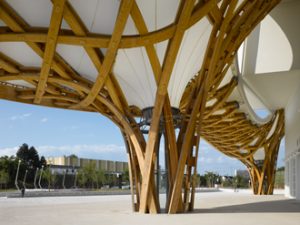
3. Detail of the roof’s frame, Pompidou Center-Metz. © Centre Pompidou-Metz; Shigeru Ban Architects Europe and Jean de Gastines Architectes, with Philip Gumuchdjian for the competition-winning project design/Metz Métropole/Pompidou Center-Metz/Photo: Roland Halbe.
The architects put forward a plan with three galleries stacked one atop the other and oriented in different directions. The first exhibition space, located on the ground floor, is the Main Nave. With its impressive volume, it is unique in France: the surface area is 1,200 square meters and the ceiling is 6, 13, and 21 meters in height. This space allows for the presentation of large-scale works, some of which cannot be presented in Paris. The Studio, also on the ground floor, welcomes exhibitions and installations as well as live performances. Further on, the 144-seat capacity Auditorium is used for lectures and films. The exhibition galleries, 85 meters long, 15 meters wide, and 7 meters high, are situated 7, 14, and 21 meters above ground level. Each one is more than 1,100 square meters in area, with no point of support. A gallery can be totally cleared, or partitioned to whatever extent one wants, to fit with the varying scenographic visions for different exhibitions. Located at the end of each gallery is a 14×5-meter window that offers a cinemascope view of the urban landscape (Fig. 4). The floor is made of uniformly perforated slabs of calcium sulfate, which facilitates uniform distribution of the air conditioning and a climatic stability, no matter how the room is divided. A false ceiling integrates indirect lighting as well as tracks into which spotlights can be plugged. Transparency, movement, fluidity, and flexibility are factors that serve to facilitate the visitor’s encounter with the works themselves. Playing on the relationship between inside and outside, the spaces are arranged around a hexagonal tower that reaches the height of 77 meters–an allusion to the year the Pompidou Center opened in Paris (1977). This tower houses elevators that allow panoramic views as well as the main staircase. The facades of the Forum are fitted with transparent retractable panels 6 meters in height that permit good ventilation and allow one to open the Forum fully onto the courtyard and garden.
Cultural Policy
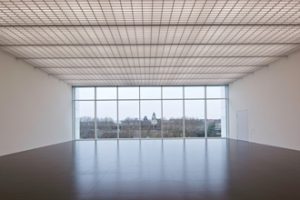
4. Gallery with a view of the city, Pompidou Center-Metz. © Centre Pompidou-Metz; Shigeru Ban Architects Europe and Jean de Gastines Architectes, with Philip Gumuchdjian for the competition-winning project design/Metz Métropole/Pompidou Center-Metz/Photo: Olivier H. Dancy.
Bearing witness to the diversity of contemporary cultures, broadening public attendance to include new audiences, rekindling the visitor’s relationship to art, and creating a lively place for social gatherings and interactions are the essential aims of the Pompidou Center-Metz.
Not possessing any collections of its own, the Pompidou Center-Metz exclusively designs temporary exhibitions while centering its cultural policy around a reflection on how works are to be shown. From the genesis of this project onward, the top imperatives have been to help to highlight the French National Museum of Modern Art’s art collection and to allow a (re)discovery of the works that make up that collection. From the outset, the French National Museum of Modern Art has offered shows that, in the words of Dominique Bozo, tend “to map contemporary art rather than to provide a genealogy of it.” The Pompidou Center-Metz has set out to pursue this line of experimentation by proposing exhibitions that offer new readings of the history of art since 1905.
n parallel with these temporary shows, a multidisciplinary approach to programing (live performances, films, lectures) is offered to the public in the spirit of the Pompidou Center. The programming includes all fields of artistic creation and is centered in the main around the themes of the exhibitions as extensions of them.
“Masterpieces?”
The Pompidou Center-Metz’s inaugural exhibition, “Masterpieces?”, filled up all the exhibition spaces, or more than 5,000 square meters, and presented 800 works, including 700 from the collection of the French National Museum of Modern Art, thus constituting the largest loan operation in the history of the Pompidou Center. In addition, it received loans from other institutions as well as works from contemporary artists that were executed especially for the occasion. Intended for the general public as well as for the specialist, the exhibition fostered a dialogue between famous pieces and others that are less well known while inviting the visitor to question himself about his own appreciation of the works shown. In order to illustrate the richness of the collections, which are made up of large monographic donations, several series of presentations were organized around such key names in twentieth-century art as George Braque, Robert Delaunay, Fernand Léger, Henri Matisse, and Pablo Picasso. This exhibition allowed comparisons between César’s Compression “Ricard” and Ben’s Le Magasin, between Delaunay’s decorations for the 1937 Paris World’s Fair and Henri Matisse’s cut paper collages, and between Georges Méliès’s A Trip to the Moon and Constantin Brâncusi’s Sleeping Muse (Fig. 5).
The itinerary of the show was divided into four sections: “Masterpieces Throughout History,” “Stories Behind Masterpieces,” “Masterpiece Dreams,” and “Masterpieces Ad Infinitum.” The exhibition questioned in a novel way the notion of the masterpiece as well as its history and its topicality. Reflection on this old notion, now sometimes considered outdated, has been reactivated and applied to modern and contemporary art.
Echoing the major exhibitions that made the reputation of the Pompidou Center, the approach was multidisciplinary, as the exhibition included paintings, sculptures, installations, graphic art, photography, videos, acoustical works, films, architecture, and design throughout the show’s itinerary. The exhibition also covered a broad chronological swath from the Middle Ages up until today.
An exceptional show on more than one account, “Masterpieces?” will gradually give way to future temporary shows at a rate of four or five a year. Along with the rest of the Pompidou Center-Metz’s programming, these exhibitions, which will serve to delineate its cultural identity, include a commission for a work by Daniel Buren (Echoes, Works in Situ) and then the thematic exhibition “Wander, Labyrinthine Variations,” as well as a first major monographic exhibition, organized around the designers Ronan and Erwan Bouroullec. In 2012, an unprecedented retrospective of the mural drawings of Sol LeWitt, accompanied by works from his private collection, and the exhibition “1917”–whose subject, presented on an international scale, is wartime artistic creativity during the year 1917–will be presented.
The Pompidou Center-Metz was inaugurated on May 11, 2010 by the President of the French Republic. The opening of the Pompidou Center-Metz was an exceptional public success, with, in total, nearly 100,000 people participating during the inaugural week of events May 10-16, 2010.
A year after its opening, attendance has reached the figure of 800,000 visitors, including 20,000 subscribers to the Pass, an annual membership card that allows one to visit exhibitions an unlimited number of times. Eighty-six percent of the visitors to the Pompidou Center-Metz are French, and among them the majority are from the Lorraine region. With more than 60 percent of the visitors residing in the Moselle département, the Pompidou Center-Metz is the main motivation for their trips to Metz. Thirty-three percent of visitors report that they have come to Metz for the first time. A clear increase in economic activity for the city Metz has thus been noted. These results rank the Pompidou Center-Metz as the most frequented museum among French cultural institutions outside the Île de France region.
Selected Bibliography
LE BON, Laurent. Ed., Chefs-d’œuvre ? (exhibition catalogue). Metz: Centre Pompidou-Metz, 2010.
JODIDIO, Philip, with Laurent LE BON and Aurélien LEMONIER, Eds., Chefs-d’œuvre ?, Architectures de musées, 1937-2014. Metz: Centre Pompidou-Metz, 2010.
JODIDIO, Philip with Laurent LE BON. Centre Pompidou-Metz. Paris: Centre Pompidou / Prestel, 2008.
Laurent Le Bon. A General French Heritage Curator, Laurent Le Bon is a graduate of the French Institute of Political Studies (IEP) and the École du Louvre. He was in charge of public commissions at the Visual Arts Delegation in the French Ministry of Culture and then became a French National Museum of Modern Art curator at the Pompidou Center for the period 2000 to 2010. He has organized numerous exhibitions, in particular “Dada” at the Pompidou Center and “Jeff Koons Versailles” at the Palace of Versailles. Since 2008, he has been the Director of the Pompidou Center-Metz, which was inaugurated in May 2010 with the “Masterpieces?” show he himself organized.
Le Bon has taught at the École du Louvre and at Sciences Po Paris. He has published, among other works, Catalogue de raison, Ronan et Erwan Bouroullec (Éditions Images modernes) and L’Art à ciel ouvert, coedited with Caroline Cros (Éditions Flammarion).
